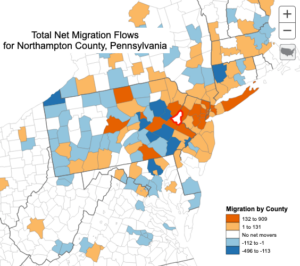In Battleground Pennsylvania, Is Northampton Still a Swing County?
EASTON, PENNSYLVANIA — As the 2024 presidential campaign progresses through a crazy year, the news media are increasingly focused on swing counties such as Northampton in Pennsylvania — counties that have flipped back and forth in recent elections. The aim is to find the voters who changed their minds and who could again.
In many ways, Northampton fits the swing county label to a tee. But when you look closer, its “swinging” may be more about changing who votes rather than changing how they vote.
In the 2012 presidential race, Democrat Barack Obama carried Pennsylvania and this county by about five percentage points on 131,000 votes cast. In 2016, Republican Donald Trump won Pennsylvania and, of course, the presidency, and he carried Northampton by about four percentage points as 144,000 people voted in the county. Four years later, Democrat Joe Biden won Northampton by less than one percentage point after 171,000 people voted.
That’s an increase of 40,000 votes in just three elections with different parties carrying the county. Does that mean the 2024 campaign here is a battle over turnout?
Well, yes and no.
A County’s Emerging New Identity
Northampton is changing. Sitting north of the Philadelphia metro area on the eastern border with New Jersey, the county has a rich manufacturing history. It is the home of Bethlehem, and Allentown (where Billy Joel sang about how all the factories were closing down in the 1980s) sits just to the west in Lehigh County. But that’s not really the story of this place anymore.
Instead, Northampton is morphing into a more solid version of what the American Communities Project calls an Urban Suburb, the kind of place that has become an important cache of votes for the Democrats.
In the last iteration of the ACP typology, Northampton was a Middle Suburb, but in the past decade, the county has grown more populous and more racially and ethnically diverse, all while seeing increases in the number of bachelor’s degrees among its citizenry. In other words, this isn’t Bill Joel’s Lehigh Valley anymore.
Race and Ethnicity
Since 2010, Northampton has grown by more than 20,000 residents. Most of that growth — 13,000 residents — has arrived since 2019, according to Census data. But more important, that growth has brought demographic change. The county’s white, non-Hispanic population has actually declined by about 12,000 in that time, while the Black and Hispanic numbers have increased.
The county’s residents are still predominantly white and non-Hispanic, but those numbers represent about a nine-percent point drop in the white, non-Hispanic population. In terms of its racial and ethnic composition, the place looks more like the nation as a whole today than it did back in 2010.
Employment
In that same time, jobs in the county moved away from manufacturing and toward educational, health care, and professional services.
There were about 3,000 fewer manufacturing jobs in the county in 2022 (the latest Census data) than in 2010. Educational and health service jobs increased by about 7,300 in that time, according to the Census. Professional and scientific service jobs increased by 3,200. The top 10 employers in the county in the fourth quarter of 2023 included Lehigh University, Bethlehem Area School District, and St. Luke’s Hospital.
And since 2010, the county’s median household income went from about $56,700 to $74,700, which, even adjusting for inflation, was an increase of about $1,000 in real income.
New Residents
Then there is the issue of where Northampton’s new residents are from. This is something one can explore using the U.S. Census’s cross-county migration data, which looks at the inflows and outflows of every county in country. Below is a map of the population inflows and outflows for Northampton in the 2016-2020 time period. The dark and light oranges show where people who move to the county come from; the light and dark blues show where people move to when they leave county.

The inflows show a lot of incoming metro New York residents. Why? It may seem like a long way, but Easton, Pennsylvania, is only 76 miles from midtown Manhattan. And in a world in which going into the office has become much less frequent, that commute may not sound awful to some. Regardless of the reason, people in Northampton say New York commuters are much more common here than they were a few years back.
All these changes raise questions about Northampton’s position as a swing county this November. For sure, it is not the place it was 12 years ago or even 4 years ago — and that’s something to keep in mind at election time. The nation is always changing, and the Covid pandemic probably accelerated the changes in some places.
Growing racial and ethnic diversity, professional employment, and an influx of urbanites are all telltale signs that a place is becoming an Urban Suburb. If those trends continue, Northampton’s place in the political landscape as a “swing county” may be numbered.
